[wp_ad_camp_1]
Heracles
In Greek mythology, Heracles was Zeus & Alcmene’s son.
Zeus’ wife, Hera, was pretty ticked off that Zeus was making whoopee with a mortal so when she found out Alcmene was about to give birth, she scurried to her house. She wanted to slow the birth by getting Alcmene to sit cross-legged, with her clothes tied in knots.
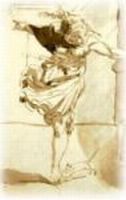 But Alcmene’s wiley servant, Galanthis, foiled the plot by telling Hera that Alcmene had already given birth.
But Alcmene’s wiley servant, Galanthis, foiled the plot by telling Hera that Alcmene had already given birth.
When Hera found out that she had been deceived, she was so angry with Galanthis that she twitched her nose (well, maybe she didn’t do that exactly) turned Galanthis into a weasel and forced her to give birth by laying eggs through her mouth.
Eggs …..?
Æsop [c 620-560 BC]
Æsop is supposed to have been a freed slave from Thrace whose collection of fables was passed on through oral tradition.
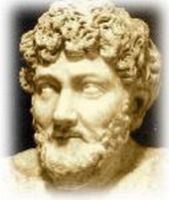 Apparently many of his fables were rewritten in Greek verse by a Hellenised Roman poet named Babrius around the 1st or 2nd century AD, while Phaedrus, another Roman poet, wrote the fables in Latin verse in the 1st century AD.
Apparently many of his fables were rewritten in Greek verse by a Hellenised Roman poet named Babrius around the 1st or 2nd century AD, while Phaedrus, another Roman poet, wrote the fables in Latin verse in the 1st century AD.
Æsop wrote two fables about weasels –
With two of the fables about weasels eating mice, it’d be a safe bet to say that they were used for that purpose way back in 600 BC!
There is a book on the market called “Aesop, The Complete Fables”, translated by Olivia and Robert Temple [Penguin Classics. New York], which was reviewed by Laura Gibbs.
The reviewer took umbrage to the fact that the Temples chose to translate the Greek word “gale” as house-ferret, which she claims “is dubious at best”, since the word refers to weasels in general.
Not only that, but apparently the Temples don’t explain why they’ve asserted, without documentation, that “the house-ferret, otherwise known as the domesticated polecat, was the chief household pet” of ancient Greece.
So, if you want to get a book about Æsop’s Fables with tales of ferrets, I guess that would be a good one to buy, but be prepared for arguments if you have friends who are classical scholars!
There was another fable by Æsop concerning Aphrodite, the goddess of love, sex & marriage.
“A weasel once fell in love with a handsome young man and the blessed goddess Kypris [Aphrodite], the mother of desire (pothon meter), allowed the weasel to change her shape, so that she appeared to be a beautiful woman whom any man would be glad to take as his wife. As soon as the young man laid eyes on her, he also fell in love and wanted to marry her. While the wedding feast was in progress, a mouse ran by. The bride leaped up from her richly decorated couch and began to run after the mouse, thus bringing an end to the wedding. After having played his little joke, Eros took his leave: Phusis (Nature) had proved stronger than Eros (Love).” ~ Æsop Fables 350 (from Babrius 32)
There was a common Greek proverb ‘weasels don’t wear wedding gowns’ (Zenobius 2.93) associated with this fable.
Greek Poets of the 7th Century BC
I only found two poets who referred to weasels in their works and what a pair of misogynists they seemed to be! I wasn’t sure which they disliked more, weasels or women!
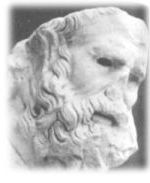 Archilochus of Paros talked about a “weasel woman” as “wretched and undesirable; has no lovable traits; good for sex but not for conversation; she steals from her neighbors“.
Archilochus of Paros talked about a “weasel woman” as “wretched and undesirable; has no lovable traits; good for sex but not for conversation; she steals from her neighbors“.
(He certainly looks like a miserable old man, doesn’t he! Probably got dumped by some spunky mole and took it out on women in his poems!)
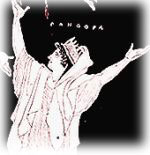 And old Semonides of Amorgos seemed to enjoy satirizing women and compared them to different animals … “another loathsome, miserable type is from a weasel: undesirable in every way – un-charming, un-alluring“.
And old Semonides of Amorgos seemed to enjoy satirizing women and compared them to different animals … “another loathsome, miserable type is from a weasel: undesirable in every way – un-charming, un-alluring“.
Sounds like a real charmer ….. not! 
Herodotus [c 485-425 BC]
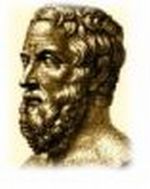 Herodotus is considered the first Greek historian whose work, The Histories, is a story about the war between the huge Persian Empire and the smaller Greek city-states.
Herodotus is considered the first Greek historian whose work, The Histories, is a story about the war between the huge Persian Empire and the smaller Greek city-states.
In that work (Book IV-192), he mentions that weasels were found in the Silphium region of Libya.
Weasels also are found in the Silphium region, much like the Tartessian. So many, therefore, are the animals belonging to the land of the wandering Libyans, in so far at least as my researches have been able to reach.
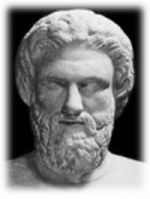 Aristophanes wrote most of his plays during the Peloponnesian War, to which he was opposed, as well as being against the policies of the decadent Athenian democracy. Not only did he ridicule the leaders in his comedies, but he also attacked the democratic institutions in Athens.
Aristophanes wrote most of his plays during the Peloponnesian War, to which he was opposed, as well as being against the policies of the decadent Athenian democracy. Not only did he ridicule the leaders in his comedies, but he also attacked the democratic institutions in Athens.
He mentions the weasel in two of his plays and strangely enough, in both of them his characters refer to farts, which stank worse than a weasel!
In his play, Plutus, a character called Cario talks about an old woman (what is it with these ancient Greek playwrights and old biddies?) and says, “On hearing the noise I made the old woman put out her hand, but I hissed and bit it, just as a sacred serpent might have done. Quick she drew back her hand, slipped down into the bed with her head beneath the coverlets and never moved again; only she let flee a fart in her fear which stank worse than a weasel.
Then in The Archarnians, Dicæopolis says “Come, my child, carry the basket gracefully and with a grave, demure face. Happy he who shall be your possessor and embrace you so firmly at dawn, that you fart like a weasel.”
I wonder what Aristophanes would have said if he was around Bonnie, our German Shepherd, when she fluffs. I reckon it would’ve made his eyes water and change his opinion about how bad weasels smell! 
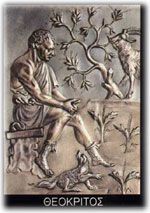 Theocritus was born in Syracuse, Sicily, spent time on the island of Kos and was also a member of the Pleiad of Alexandrian poets under Ptolemy II in Alexandria.
Theocritus was born in Syracuse, Sicily, spent time on the island of Kos and was also a member of the Pleiad of Alexandrian poets under Ptolemy II in Alexandria.
He has been called the creator of pastoral poetry and wrote 30 idyllic poems, as well as 24 short epigrams.
In Idyll XV, titled Going to a festival, Egypt, Praxinoa moans to Eunoa:
“Every day is a holiday if you don’t work. Eunoa – you lazy – pick up that spinning and put it back in the centre again. Weasels like to sleep on soft beds. Move, bring me some water, right now. She was supposed to bring water; she brought soap. Give it to me anyway. Not so much, you pirate. Pour on the water. Stupid – why are you getting my cloak wet? Now stop. I’ve washed as well as the gods permit it. Where is the key to the big chest? Then bring it.”
I must say that the reference to weasels sleeping on soft beds has got me stumped.
Mind you, my weasels love sleeping in our bed in the winter so who knows, maybe the weasels felt the same way after a day of chasing rats and mice around the house!
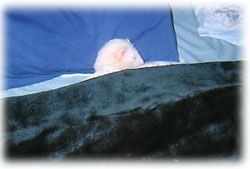
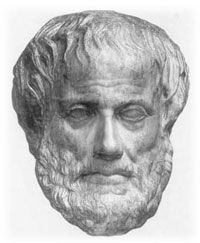 Aristotle was born in Stagirus in Macedonia. His father was a doctor and a member of the Asclepiadae.
Aristotle was born in Stagirus in Macedonia. His father was a doctor and a member of the Asclepiadae.
Although orphaned at a young age, it appears that he had some training in medical and biological matters from his father. He was one of the very first to write detailed observations on plants and animals in his “Historia Animalium”.
Historia Animalium [c 350BC] BOOK II Part 1
In the male organ itself there is a great diversity. For in some cases the organ is composed of flesh and gristle, as in man; in such cases, the fleshy part does not become inflated, but the gristly part is subject to enlargement. In other cases, the organ is composed of fibrous tissue, as with the camel and the deer; in other cases it is bony, as with the fox, the wolf, the marten, and the weasel; for this organ in the weasel has a bone.
Book IX Part 1
The so-called presbys or ‘old man’ is at war with the weasel and the crow, for they prey on her eggs and her brood; and so the turtle-dove with the pyrallis, for they live in the same districts and on the same food; and so with the green wood pecker and the libyus; and so with kite and the raven, for, owing to his having the advantage from stronger talons and more rapid flight the former can steal whatever the latter is holding, so that it is food also that makes enemies of these.
The snake is at war with the weasel and the pig; with the weasel when they are both at home, for they live on the same food; with the pig for preying on her kind. The merlin is at war with the fox; it strikes and claws it, and, as it has crooked talons, it kills the animal’s young. The raven and the fox are good friends, for the raven is at enmity with the merlin; and so when the merlin assails the fox the raven comes and helps the animal.
Part 6
The weasel, when it fights with a snake, first eats wild rue, the smell of which is noxious to the snake. The dragon, when it eats fruit, swallows endive-juice; it has been seen in the act. Dogs, when they suffer from worms, eat the standing corn. Storks, and all other birds, when they get a wound fighting, apply marjoram to the place injured.
Many have seen the locust, when fighting with the snake get a tight hold of the snake by the neck. The weasel has a clever way of getting the better of birds; it tears their throats open, as wolves do with sheep. Weasels fight desperately with mice-catching snakes, as they both prey on the same animal.
The polecat or marten is about as large as the smaller breed of Maltese dogs. In the thickness of its fur, in its look, in the white of its belly, and in its love of mischief, it resembles the weasel; it is easily tamed; from its liking for honey it is a plague to bee-hives; it preys on birds like the cat.
Its genital organ, as has been said, consists of bone: the organ of the male is supposed to be a cure for strangury; doctors scrape it into powder, and administer it in that form.
I find it quite interesting that Aristotle mentions the polecat, saying that it is easily tamed. Could this statement be proof of when the polecat (ferret?) first became domesticated?
How gross to think the doctors in those days used to harvest polecats’ baculi to give to help those suffering from strangury (kinda like cystitis).
And where it talks about the weasel eating wild rue before fighting a snake — I read that rue has an almost hallucinogenic affect so could it be just a tall tale which says the weasel has to dope itself up to fight a snake?
I mean, we all know that a weasel is an incredibly lithe and fast animal. Maybe that wild rue thing is all nonsense and the little mustelid just has chutzpah 
BTW, to this day wild rue is used in many Zoroastrian ceremonies, rituals and purification rites. It is believed to keep the evil eye away and bring on plenty of health.
Hmmm, maybe the weasel did have a chew on it before heading off to battle?!?
On the Parts of Animals [c 350BC] Book III
The heart is of large size in the hare, the deer, the mouse, the hyena, the ass, the leopard, the marten, and in pretty nearly all other animals that either are manifestly timorous, or betray their cowardice by their spitefulness.
Well, I don’t know the marten’s personality – I suppose it could be timorous but I’m sure that it would never “betray its cowardice by spitefulness”!
Nicomachean Ethics [c 350BC] Book VII
For every excessive state whether of folly, of cowardice, of self-indulgence, or of bad temper, is either brutish or morbid; the man who is by nature apt to fear everything, even the squeak of a mouse, is cowardly with a brutish cowardice, while the man who feared a weasel did so in consequence of disease; and of foolish people those who by nature are thoughtless and live by their senses alone are brutish, like some races of the distant barbarians, while those who are so as a result of disease (e.g. of epilepsy) or of madness are morbid.
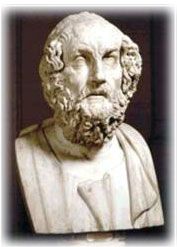 Strabo was born in Amaseia (now Amasya, Turkey), the son of wealthy parents.
Strabo was born in Amaseia (now Amasya, Turkey), the son of wealthy parents.
His “Geographia” is said to have been composed between 9-5 BC with parts revised around 18-19 AD.
Geographia Accounts of Ancient Mauretania XVII.iii.
The country is the fruitful nurse of large serpents, elephants, antelopes, buffaloes, and similar animals; of lions also and panthers. It produces weasels (jerboas?) equal in size and similar to cats, except that their noses are more prominent, and multitudes of apes, of which Poseidonius relates that when he was sailing from Gades to Italy, and approached the coast of Africa, he saw a forest low upon the sea-shore full of these animals, some on the trees, others on the ground, and some giving suck to their young.
Accounts of Tartessus
As you have read in Herodutus’ Libyan description, the weasels of Silphium are similar to the weasels of Tartessus. This was the ancient name of southern Spain, about which Strabo says:
There is a superabundance of cattle and a great variety of game, while on the other hand there are certain little hares which burrow in the ground (rabbits). These creatures destroy both seeds and trees by gnawing their roots. They are met with throughout almost the whole of Spain. It is said that formerly the inhabitants of Majorca and Minorca sent a deputation to the Romans requesting that a new land might be given them, as they were quite driven out of their country by these animals, being no longer able to stand against their vast multitudes.”
I would imagine that the weasels of Tartessus had a field day chasing the rabbits throughout the countryside! 
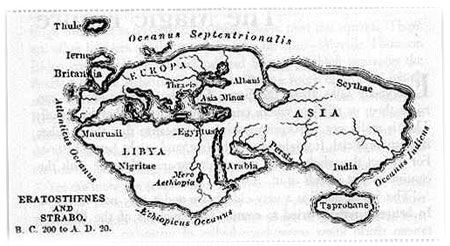
Egyptian references in Geographia
Strabo talks about the ichneumon (Egyptian mongoose, pictured below) being an animal peculiar to Egypt in Augustus’ time. This animal was a member of the Viverridae family (mongoose, meerkat, civet, genet) which used to attack snakes and eat crocodile eggs. The ichneumon, along with the shrewmouse, were associated with the sun god and were honoured, particularly during the late and Greco-Roman Periods, with burial and small bronze statuary.
Perhaps that’s where the popular misconception of ferrets starting out in Egypt came from, since I would imagine a drawing or statue of a mongoose or meerkat might look remarkably like a weasel or ferret.
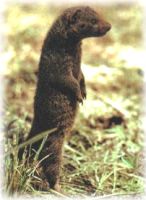
[wp_ad_camp_3]
Return from Weasels in Ancient Greece to All About Ferrets
